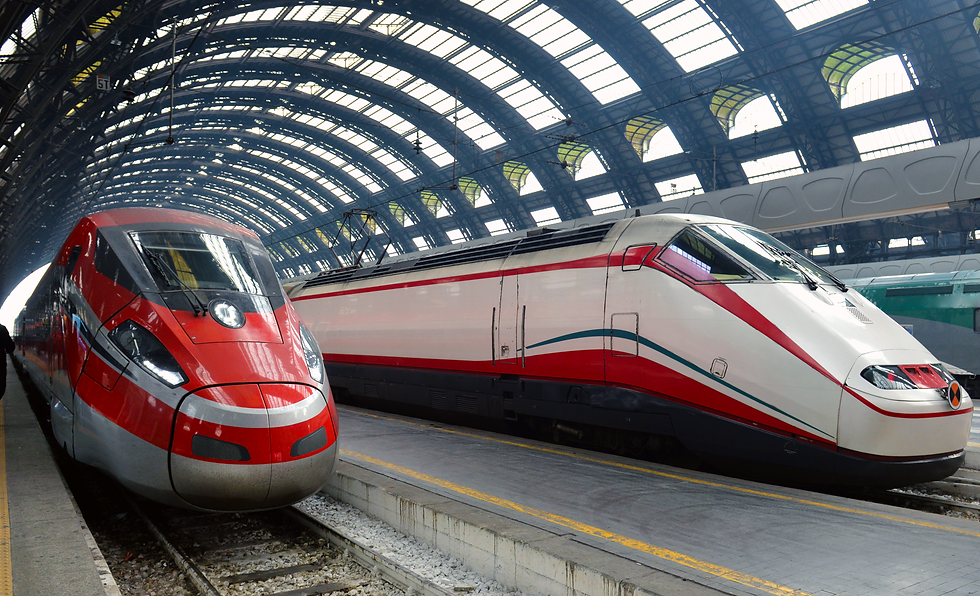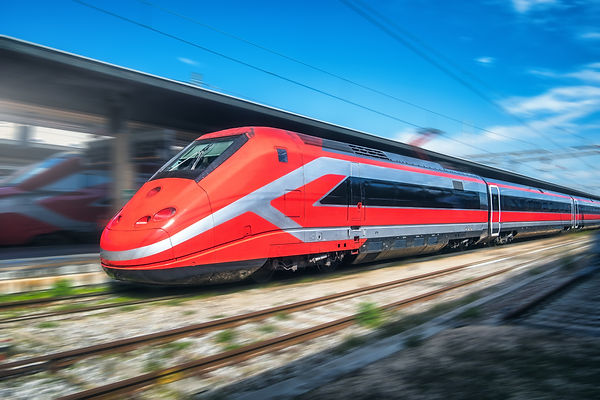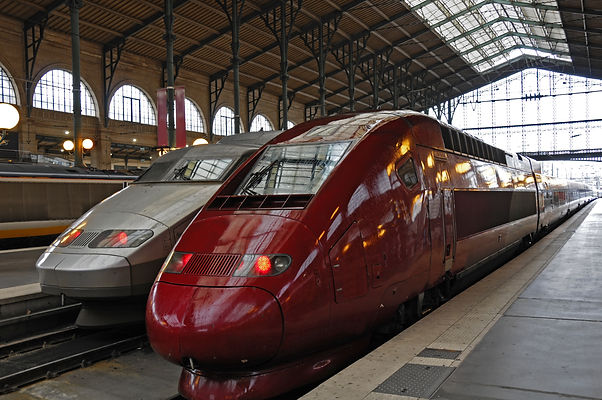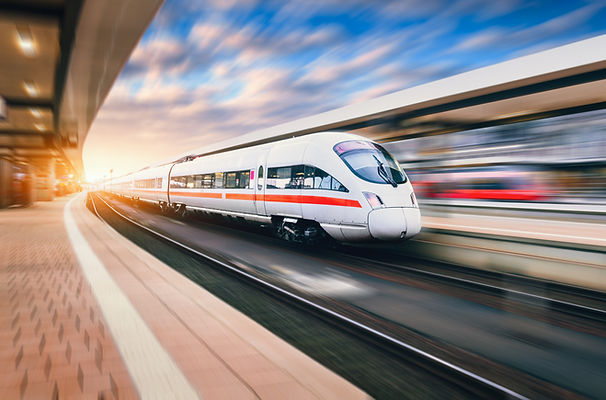
train travel
Whether you're a seasoned globetrotter or a first-time visitor to Europe, one question that's likely crossed your mind is: "How should I get around?" While renting a car might seem like an appealing option, there's another mode of transport that offers its own unique advantages: the train. A stalwart of European travel, train journeys across this diverse continent provide an experience that goes beyond mere transportation. In this blog post, we delve into the world of European train travel, examining its worth, and how it stacks up against car rental.
Chasing the Horizon: The Merits of Train Travel
Train travel is an integral part of the European experience. The continent boasts an incredibly dense railway network that connects both major cities and small towns, offering unparalleled access to the mosaic of cultures, histories, and landscapes that Europe encompasses.
The key advantage of train travel is convenience. Train stations are usually centrally located, saving you the time and stress of navigating through busy city traffic or finding parking. They provide a direct link to the heart of the cities, opening a window to the architectural grandeur and cultural vibrancy that is quintessentially European.
There's a unique romance associated with train travel. You're not just moving from point A to B, but immersing yourself in a journey, a rhythmic dance of changing landscapes. From the emerald hills of Scotland, the sunflower-strewn fields of Provence, to the rugged coastline of the Cinque Terre, the scenic vistas are a visual feast that's difficult to replicate when you're focused on the road.
Environmentally, trains are a greener alternative. With increasing awareness about the environmental impact of our travel choices, trains offer a more sustainable mode of transportation compared to cars, aligning with the increasing push towards responsible travel.
Weighing the Costs: Train Travel vs. Renting a Car
Comparing the cost of train travel and car rentals isn't straightforward, as it depends on various factors like distance, country, and the type of car or train ticket. Generally, for long distances and cross-country journeys, trains tend to be more cost-effective. They save you from the additional costs associated with car travel, such as fuel, tolls, parking fees, and rental insurance.
On the other hand, train ticket prices vary significantly based on the type of train, class of service, and when you book. High-speed trains and peak travel times will be more expensive. However, by booking in advance, traveling off-peak or overnight, or using rail passes like Eurail (for non-EU citizens) or Interrail (for EU citizens), you can secure significant savings.
Navigating the Pros and Cons
Like any mode of transportation, train travel in Europe has its pros and cons.
Pros:
Scenic Routes: Trains offer a relaxing way to enjoy Europe's stunning landscapes.
Convenience: No navigating through traffic, no parking hassles, and stations are usually central.
Comfort and Space: More legroom than cars and planes, and the freedom to move around.
Environmental Impact: Trains are more eco-friendly than cars.
Social Aspect: Meeting fellow travelers on trains can lead to enriching experiences.
Cons:
Schedule Restrictions: You're bound by the train timetable.
Limited Coverage: Some rural or remote areas may not be accessible by train.
Variable Costs: Train fares can fluctuate based on time of booking and type of train.
To Train or Not to Train
So, is train travel in Europe worth it? Absolutely, if you value convenience, comfort, scenic value, and a lower environmental impact. While car travel offers more flexibility and can be more economical for short distances or smaller countries, trains win in terms of stress-free, picturesque, and eco-friendly long-distance travel.
Ultimately, the choice between train travel and car rental in Europe boils down to your personal preferences, itinerary, and the kind of experience you wish to have. Both offer unique ways to experience the enchanting diversity of Europe. Choose the one that resonates with your travel style and let the adventure unfold.

train travel in italy
Train travel and Italy – it's a match made in heaven. The allure of traversing through sweeping landscapes, rustic towns, and bustling metropolises aboard Italy's well-connected rail system is an experience like no other. Whether you're sipping on an espresso as you speed past the Tuscan countryside or peering out over the Mediterranean coastline, Italy's trains offer a rich tapestry of experiences. In this blog post, we delve into the ins and outs of Italian train travel, exploring the different operators, train types, and classes.
Italy's Rail Operators
Train travel in Italy is primarily managed by two main operators: Trenitalia and Italo.
1. Trenitalia
As the national railway company, Trenitalia offers the most extensive network, serving every nook and cranny of Italy, from major cities to small towns. It operates a wide variety of trains, from high-speed services to regional lines.
2. Italo
Italo is a private company that runs high-speed trains on the main north-south axis from Turin and Venice in the north to Salerno in the south, with stops in key cities such as Milan, Bologna, Florence, Rome, and Naples. Though it serves fewer destinations than Trenitalia, Italo is known for its modern trains and high-quality service.
Types of Trains in Italy
The Italian rail system features a diverse range of trains to cater to different travel needs and budgets:
1. High-Speed Trains
These are the fastest and most modern trains. Trenitalia's Frecciarossa, Frecciargento, and Frecciabianca trains, as well as Italo trains, fall into this category. They connect Italy's main cities at speeds up to 300 km/h, offering a quick and comfortable journey.
2. Intercity Trains
These trains connect over 200 locations across Italy. They are slower than high-speed trains but faster than regional ones.
3. Regional Trains
Operated by Trenitalia, these are the slowest and most affordable trains, stopping at every station. They're ideal for short distances and for reaching smaller towns and villages.
Train Classes in Italy
Italian trains typically offer two classes – First Class (Prima Classe) and Second Class (Seconda Classe):
1. First Class
First-class compartments provide larger, plush seats, extra legroom, and fewer seats per carriage, providing a more relaxed travel environment. High-speed trains in the first class often offer additional amenities like complimentary drinks, snacks, free Wi-Fi, and power outlets.
2. Second Class
Second class offers a comfortable and more economical travel option. While the seats are smaller, and there are more of them per carriage, they are well-maintained and certainly comfortable for long journeys.
Some Italo trains and Trenitalia's Frecciarossa also offer a premium level above first class, such as 'Club Executive' or 'Business'. These provide luxuries such as reclining leather seats, gourmet meal service, and access to lounges at the station.
Embarking on Your Italian Rail Journey
Train travel in Italy offers a convenient, enjoyable, and eco-friendly way to explore the country’s diverse regions. With an array of options from high-speed sprints between major cities to leisurely rides through scenic countryside, there's a train for every traveler in Italy. As you ride along the rails of Italy, each glance out of the window paints a picture that's worth a thousand words. So sit back, relax, and let the charm of Italy unfurl before your eyes. Buon viaggio!
Italian Main Train Stations and Cities:
-
Milan: Milano Centrale
-
Rome: Roma Termini
-
Florence: Firenze Santa Maria Novella
-
Venice: Venezia Santa Lucia
-
Pisa: Pisa Centrale
-
Turin: Torino Porta Nuova
-
Naples: Napoli Centrale
-
Verona: Verona Porta Nuova
-
For Cinque Terre: Livorno Centrale - Starting Point

train travel in france
Train travel is synonymous with the French way of life. France's extensive and efficient railway network, coupled with its diverse landscapes and rich cultural heritage, makes train travel one of the most enjoyable ways to explore this beautiful country. This guide aims to introduce you to the ins and outs of the French railway system, covering train operators, types of trains, and travel classes.
France's Rail Operators
When we talk about trains in France, one operator rules the roost - the Société Nationale des Chemins de Fer, more commonly known as SNCF. As the national railway company, SNCF operates the majority of rail services in France, from local commuter lines to high-speed intercity routes.
However, the liberalization of the railway market in Europe has led to the emergence of new operators in recent years. OUIGO is SNCF's low-cost high-speed train service, while Thello operates night trains between Paris and Venice. Additionally, international services like Eurostar and Thalys connect France with the United Kingdom, Belgium, the Netherlands, and Germany.
Types of Trains in France
From high-speed to regional services, France's railway system offers a variety of train types catering to different needs and preferences:
1. TGV (Train à Grande Vitesse)
As the pride of the French railway system, TGVs are high-speed trains that connect major French cities and international destinations at speeds of up to 320km/h. TGVs offer a swift and comfortable journey, often being a quicker alternative to flying when considering check-in and transfer times.
2. Intercités
Intercités are classic long-distance trains, connecting major towns and cities across France. Some Intercités services are high-speed, but most offer a slower, more leisurely ride compared to TGVs.
3. TER (Transport Express Régional)
TER trains are regional services connecting smaller towns and cities within France's various regions. These trains offer a more intimate view of France's countryside, often serving routes that high-speed trains bypass.
4. International Trains
Eurostar, Thalys, and Thello are key international train services connecting France with neighboring countries, offering a comfortable and efficient means to cross borders.
Train Classes in France
French trains typically offer two travel classes, First Class (Première Classe) and Second Class (Deuxième Classe):
1. First Class
First Class on French trains offers wider, more comfortable seats with more legroom and fewer seats per carriage. On TGVs and Intercités trains, first-class passengers might also benefit from added features such as power outlets and reading lamps.
2. Second Class
Second Class provides a comfortable journey at a more affordable price. While there is less space than First Class, Second Class seats on French trains are well-kept and comfortable for both short trips and longer journeys.
A French Rail Adventure
Train travel in France presents an opportunity to sit back, relax, and soak in the enchanting landscapes that France has to offer. Whether it's the rolling vineyards of Bordeaux, the lavender fields of Provence, or the spectacular coastline of the Côte d'Azur, each journey is a feast for the eyes. With a plethora of choices catering to different travel styles and budgets, a rail adventure in France is a ride you wouldn't want to miss. Bon voyage!

train travel in germany
Germany's geographical diversity, rich cultural history, and strategic location in the heart of Europe make it a fantastic destination for train travel enthusiasts. The German railway network is one of the most comprehensive and efficient in the world, offering a delightful mix of high-speed journeys, scenic routes, and local rides. This blog post delves into the intricacies of train travel in Germany, covering operators, types of trains, and classes of service.
Germany's Rail Operators
The main actor in the German railway scene is Deutsche Bahn (DB), the state-owned company that handles the majority of passenger rail traffic in Germany. DB operates a wide range of services, from high-speed Intercity-Express trains to regional and local services.
However, in recent years, the liberalization of the German rail market has allowed private operators to run services on certain routes. Companies like FlixTrain offer budget-conscious travellers a more affordable option, particularly on some long-distance routes.
Types of Trains in Germany
Germany's diverse railway offerings cater to different travel needs, from rapid transit between major cities to leisurely regional explorations:
1. Intercity-Express (ICE)
The flagship service of Deutsche Bahn, ICE trains are Germany's high-speed trains. These sleek, modern trains connect Germany's major cities and also provide international services to neighbouring countries. ICE trains offer amenities like free Wi-Fi, dining cars, and power outlets, and can reach speeds up to 300 km/h.
2. Intercity (IC) and Eurocity (EC)
IC trains provide long-distance services connecting cities across Germany. EC trains offer similar services but extend to international destinations in neighbouring countries. While these trains don't reach the high speeds of ICE trains, they offer a comfortable journey at a more affordable price.
3. Regional Trains (RE, RB, IRE, S-Bahn)
These trains provide local and regional services, connecting smaller towns and suburbs with larger urban centres. They're slower than ICE and IC trains but offer a great way to explore Germany's diverse regions at a relaxed pace.
Train Classes in Germany
German trains typically offer two classes of service, First Class (Erste Klasse) and Second Class (Zweite Klasse):
1. First Class
First Class on German trains offers spacious, comfortable seats with plenty of legroom. Additional perks may include quieter compartments, free newspapers, and on some ICE trains, at-seat food and drink service. On some routes, first-class passengers also have access to DB Lounges at the station.
2. Second Class
Second Class offers a comfortable journey at a more economical price. The seating arrangement is denser, but the carriages are clean, and the seats are well-maintained.
The Wonders of German Train Travel
Germany's extensive rail network and the variety of train services on offer provide travellers with a flexible and enjoyable way to discover the country's myriad attractions. From the urban allure of Berlin and Munich to the enchanting castles of the Rhine Valley, and the scenic beauty of the Black Forest, train travel in Germany is a journey of discovery that unfolds one station at a time.
So, pack your bags, grab a window seat, and let Germany's landscapes glide past you. Gute Reise!